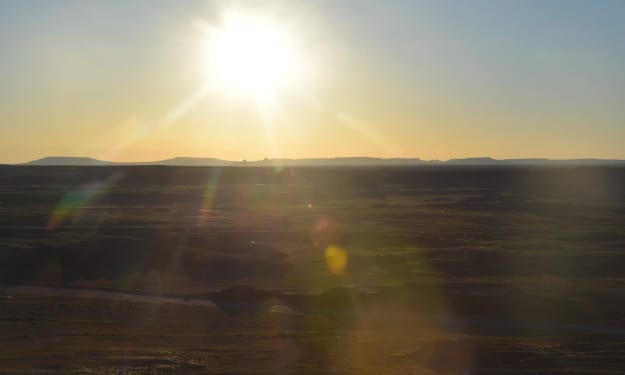If all the Antarctic glaciers melt
The sea level may rise to 66 meters

Global warming is a thesis that is increasingly being confirmed.
Since the beginning of the Industrial Revolution, human activities have had a majority impact on nature. Driven by the pursuit of economic profit, not only has biodiversity been greatly reduced, but also greenhouse gases have gradually increased, and even the ozone layer, which protects the earth from solar radiation, has been hollowed out.
Amid such a rapid industrial process, the climate problem is the one that we feel most deeply about. In recent years, the climate has become more and more unpredictable, and heat is becoming more and more common.
In addition to urban heat, the temperature of the Earth's poles and oceans is also rising. This phenomenon does not bode well.
Antarctic warming and glacial melting
The most frightening place for continued warming is not in cities but in our Antarctic region. Compared to the Arctic Ocean, the Antarctic continent is more frightening.
Although the Antarctic is called a continent, there is still an average thickness of 1,880 meters of ice on top of the continent. If the ice is included, the average altitude of the Antarctic continent is 2350 meters, which is more than twice the average altitude of Asia; if the ice is excluded, its average altitude is the third lowest.
Because of the low temperature and ice, Antarctica has become the only place without human habitation. However, even with the thick ice cover and the short duration of direct sunlight all year round, the temperature of Antarctica is gradually increasing.
In February 2015, the maximum temperature in Antarctica was 17.5°C, while in 2020, it reached 18.3°C. In the same month, the maximum temperature in Antarctica reached 20.75°C.
In just five years, Antarctica has seen a significant increase in temperature. With the increase in temperature, the Antarctic region has also produced a series of changes accordingly.
In April, British scientists said the Antarctic sea ice area has shrunk to a record low level, and the impact of the sea ice area in addition to the climate cycle is the warming caused by human activities.
The reduction in sea ice is only the beginning of an unusual change in the Antarctic for humans. But this beginning may advance the process of global warming, which will lead to the melting of Antarctic glaciers.
In physics, we all know that the white color can reflect sunlight. Set in the Antarctic words, the sea ice can reflect the sun's heat energy. But after the sea ice melts, it becomes a blue ocean, the ocean will further absorb the heat of the sun, thus accelerating the process of reducing the area of sea ice, so the vicious circle down, the Antarctic sea ice will be less and less. This will be followed by the melting of the glaciers.
Due to global warming, the global ocean heat content over the past thirty years has increased at a rate of more than five times that of the 1950s to 1980s, which also means that the Antarctic glaciers are increasingly affected.
Of course, the melting of Antarctic glaciers has also played a "feedback" role in the world. Today, the global rate of sea level rise has increased to 3.3 mm per year. Although such a figure seems relatively small, if we take the example of the disappearance of Japan's small island in the north of the nose in 2018, it may give us a sense of crisis.
The melting of a large number of Antarctic glaciers, will inevitably cause sea level rise. According to the Climate Central weather team, by 2030, some cities at lower elevations will be submerged in the ocean, such as the U.S. city of New Orleans or the water capital of Venice.
A large Antarctic glacier naturally cannot melt instantly, but when it all melts, it will have a huge global impact. Scientists estimate that if all the Antarctic glaciers melt, the global sea level will rise by about 66 meters.
In this case, some island countries or coastal cities will receive a fatal blow. When the time comes, Japan will disappear from the world map. So which Chinese cities will suffer?
Sea level rise: the disappearance of cities
The geography of China is divided into three levels of terraces, with the average elevation gradually decreasing from west to east. The average elevation of the first terrace is above four thousand meters, the second terrace is between one thousand and two thousand meters, while the third terrace is only between five hundred and one thousand meters.
Although the sea level rise of 66 meters does not have much impact on China according to the average elevation, many cities along the coast will suffer as a result.
First of all, Shanghai, the economic center of China, will be wiped out. As part of the alluvial plain of the Yangtze River Delta, Shanghai has become the economic center of China because of its unique geographical conditions that make its foreign trade very developed, but because of its proximity to the sea and the plain, the average elevation of Shanghai is only 2.19 meters.
When the Antarctic glaciers melt, the city of Shanghai will be completely reduced to the world of the sea. In addition, Shenzhen and Guangzhou are coastal, which makes them largely affected, with only some hilly areas being spared.
In addition, the coastal cities around Bohai Bay and the cities around the East China Sea will also suffer from the rising sea level. It is worth mentioning that although Beijing is not a coastal area, its average elevation is only about 40 meters, so when the North China Plain is affected, Beijing will also suffer.
Impacts of Sea Level Rise
For mankind, sea level rise will undoubtedly be a catastrophe. The current population of the earth is already more than seven billion, and even though the birth rate is getting lower, the population base is still there. If the sea level rises, the world's continental area will be greatly reduced, to avoid being submerged by the sea, the population of coastal cities will continue to move in, which will make the living environment more crowded.
In addition, the most developed areas of the world today are concentrated in the coastal areas, when the sea level rises, the first to be affected is there, which means that the global economic system will suffer significant losses. Although new coastal cities will be created afterward, it will be like a reconstruction.
What is most worrying is that in addition to the loss of cities, countries at lower elevations will also disappear. We can't guarantee that those countries won't be desperate for the sake of their own countries and peoples. If so, the whole world may be reshuffled as a result.
In times of peace, even war has to be weighed against many factors. As the power gap between countries widens, our worst fears may not come to pass.
However, coastal cities will inevitably be hit hard, and the only effective way for mankind to do so is to slow down this period. For this reason, green living and low-carbon living is the most effective thing we can do for the planet today.
About the Creator
Karen Gillanah
The aggravation that can be told is not aggravation; the lover that can be snatched away is not a lover.






Comments
There are no comments for this story
Be the first to respond and start the conversation.